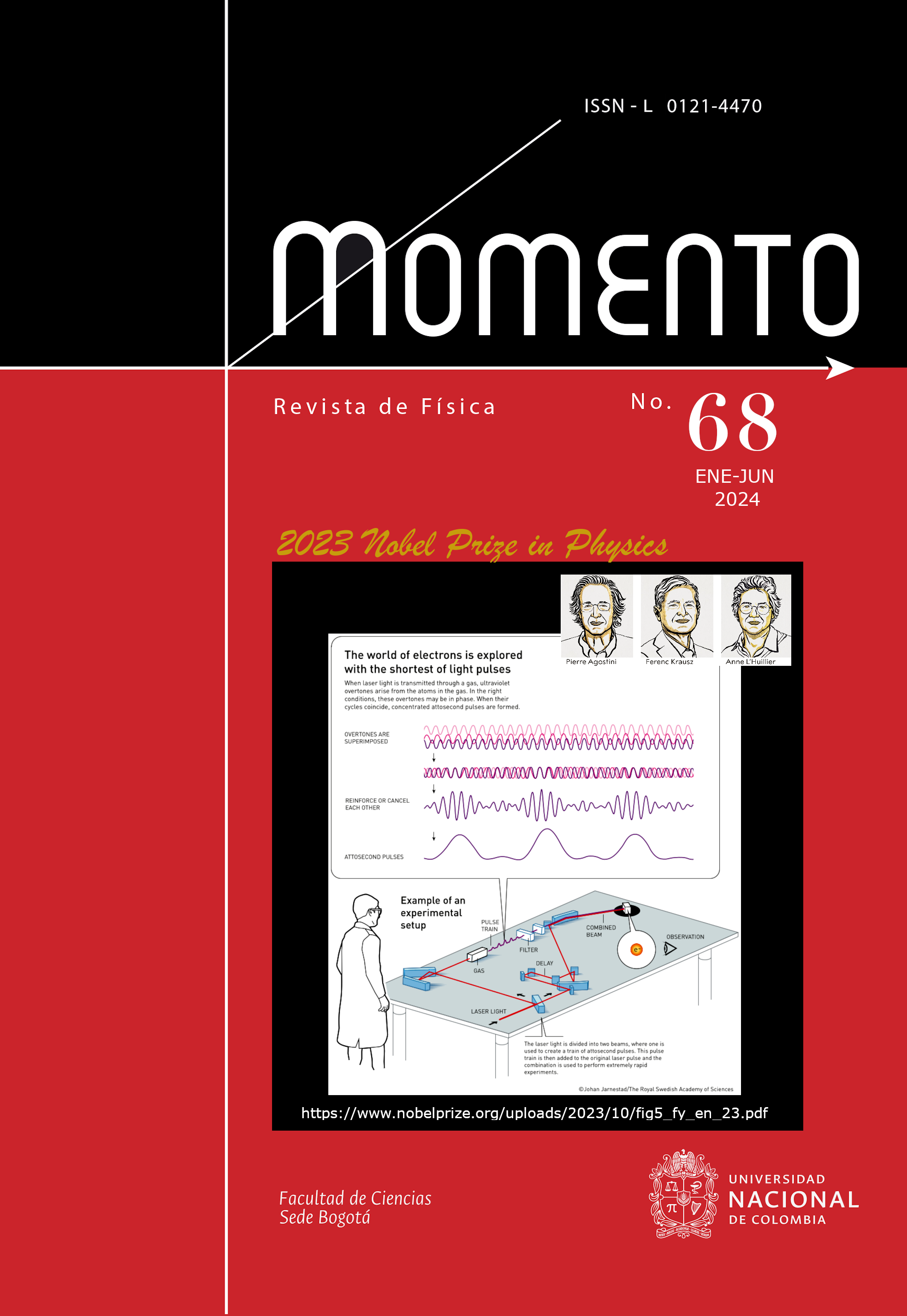INVESTIGATION AND V-I CHARACTERISTICS OF SUBSTRATE FOR MFC: CASE STUDY OF RAW HONEY
INVESTIGACIÓN Y CARACTERÍSTICAS V-I DE SUSTRATO PARA MFC: ESTUDIO DE CASO DE LA MIEL CRUDA
DOI:
https://doi.org/10.15446/mo.n68.110493Keywords:
raw honey, bioreactor, clay partition, unmediated honey (en)miel cruda, biorreactor, tabique de arcilla, miel no mediada (es)
Downloads
The world is gradually shifting from the over-reliance on fossil fuel energy to the discoveries, development, and use of various forms of renewable energy. One advancement is towards the use of Microbial Fuel Cells (MFCs). This is a bioreactor that makes use of microbial activity present in the organic substance in an electrochemical system to generate electricity. In this research, raw honey was utilized as the fuel source for fabricating a double-chambered MFC device using clay partitions. Six dilutions of the raw honey were made into Cell 1 (2 %), Cell 2 (5 %), Cell 3 (20 %), Cell 4 (40 %), Cell 5 (60 %), and Cell 6 (80 %). After fourteen days with two experiments carried out, the maximum current densities obtained were 270.2 mA/m2, 583.7 mA/m2, 654.0 mA/m2, 351.3 mA/m2, 140.5 mA/m2, 64.8 mA/m2, with the corresponding maximum power densities of 99.2 W/m2, 215 W/m2, 247.0 W/m2, 123.1 W/m2, 49.8 W/m2, 22.5 W/m2 for Cell 1, Cell 2, Cell 3, Cell 4, Cell 5, and Cell 6, respectively. It was determined that raw honey that
El mundo está abandonando gradualmente la dependencia excesiva de la energía procedente de combustibles fósiles en favor del descubrimiento, el desarrollo y la utilización de diversas formas de energía renovable. Uno de los avances es el uso de celdas de combustible microbianas (MFC). Se trata de un biorreactor que aprovecha la actividad microbiana presente en la sustancia orgánica de un sistema electroquímico para generar electricidad. En este estudio, se utiliza miel cruda como fuente de combustible para fabricar un dispositivo de MFC de doble cámara utilizando tabiques de arcilla. Se realizaron seis diluciones de miel cruda en la celda 1 (2 %), la celda 2 (5 %), la celda 3 (20 %), la celda 4 (40 %), la celda 5 (60 %) y la celda 6 (80 %). Tras catorce días en los que se realizaron dos experimentos, las densidades de corriente máximas obtenidas fueron de 270,2 mA/m2, 583,7 mA/m2, 654,0 mA/m2, 351,3 mA/m2, 140,5 mA/m2, 64,8 mA/m2, con las correspondientes densidades de potencia máximas de 99,2 W/m2, 215 W/m2, 247,0 W/m2, 123,1 W/m2, 49,8 W/m2, 22,5 W/m2 para la celda 1, la celda 2, la celda 3, la celda 4, la celda 5 y la celda 6, respectivamente. Se determinó que la miel cruda diluida puede utilizarse como fuente de combustible para crear una MFC.
References
Y. Cao, H. Mu, and et al., Microb. Cell Fact. 18, 39 (2019). https://doi.org/10.1186/s12934-019-1087-z
Wikipedia contributors, Microbial fuel cell — Wikipedia, the free encyclopedia (2023). https://en.wikipedia.org/w/index.php?title=Microbial_fuel_cell&oldid=1187244081
E. Osorio de la Rosa, J. Vázquez, and et al., Sensors 19 (2019). https://www.mdpi.com/1424-8220/19/6/1378 DOI: https://doi.org/10.3390/s19061378
R. Tamakloe, Renew. Energ. 83, 1299 (2015). https://doi.org/10.1016/j.renene.2015.04.046
I. Gajda, J. Greenman, and I. Ieropoulos, Curr. Opin. Electrochem. 11, 78 (2018). https://doi.org/10.1016/j.coelec.2018.09.006
P. Galina and L. Gorton, Curr. Opin. Electrochem. 5, 193 (2017). https://doi.org/10.1016/j.coelec.2017.09.013
R. Tamakloe, Renew. Energ. 83, 1299 (2015). https://doi.org/10.1016/j.renene.2015.04.046
H. Zhiqiang, J. Power Sources 179, 27 (2008). https://doi.org/10.1016/j.jpowsour.2007.12.094
M. Salgado, Y. Rabadzhiev, and et al., in Honey Analysis, edited by V. de Alencar Arnaut de Toledo (IntechOpen, 2017) Chap. 11. https://doi.org/10.5772/67262
O. Anjos, M. Graca, and et al., Food Chem. 169, 218 (2015). https://doi.org/10.1016/j.foodchem.2014.07.138
S. Gok, M. Severcan, and et al., Food Chem. 170, 234 (2015). https://doi.org/10.1016/j.foodchem.2014.08.040
M. Christwardana, D. Frattini, and et al., J. Power Sources 402, 402 (2018). https://doi.org/10.1016/j.jpowsour.2018.09.068
N. Ali, A. Anam, and et al., Iranian J. Biotechnol. 15, 216 (2017). https://www.ijbiotech.com/article_54457.html DOI: https://doi.org/10.15171/ijb.1608
M. Gezginci and Y. Uysal, J. Envir. Prot. Ecol. 15, 1744 (2014). https://www.researchgate.net/profile/Yagmur-Uysal/publication/270888105_Electricity_Generation_Using_Different_Substrates_and_Their_Different_Concentrations_in_MFC/links/54e5fad70cf2cd2e028b56ec/Electricity-Generation-Using-Different-Substrates-and-Their-Different-Concentrations-in-MFC.pdf
R. Tamakloe, in Proton Exchange Membrane Fuel Cell , edited by T. Taner (IntechOpen, Rijeka, 2018) Chap. 8. https://doi.org/10.5772/intechopen.71479
R. Tamakloe, M. Commey, and et al., Int. J. Adv. Res. Eng. Tech. 6, 6 (2015). https://iaeme.com/MasterAdmin/Journal_uploads/IJARET/VOLUME_6_ISSUE_6/IJARET_06_06_002.pdf
M. Kpeli, M. Donkor, and R. Tamakloe, MOMENTO 66, 59 (2023). https://doi.org/10.15446/mo.n66.102235
A. Bunaciu and H. Aboul, Chem 4, 848 (2022). https://www.mdpi.com/2624-8549/4/3/60 DOI: https://doi.org/10.3390/chemistry4030060
M. Mail, N. Rahim, and et al., Biomed. Pharmacol. J. 12, 2011 (2019). http://dx.doi.org/10.13005/bpj/1833
M. Kezierska, A. Matwijczuk, and et al., BIO Web Conf. 10, 02008 (2018). https://doi.org/10.1051/bioconf/20181002008
How to Cite
APA
ACM
ACS
ABNT
Chicago
Harvard
IEEE
MLA
Turabian
Vancouver
Download Citation
License

This work is licensed under a Creative Commons Attribution-NoDerivatives 4.0 International License.
Those authors who have publications with this journal, accept the following terms:
a. The authors will retain their copyright and will guarantee the publication of the first publication of their work, which will be subject to the Attribution-SinDerivar 4.0 International Creative Commons Attribution License that permits redistribution, commercial or non-commercial, As long as the Work circulates intact and unchanged, where it indicates its author and its first publication in this magazine.
b. Authors are encouraged to disseminate their work through the Internet (eg in institutional telematic files or on their website) before and during the sending process, which can produce interesting exchanges and increase appointments of the published work.




















